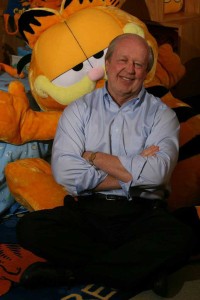![]()

Perhaps the most popular of the Garfield films, particularly considering that they began production during a period of only three major television networks, Garfield Christmas opened with a 35 share. The others followed suit. Of his involvement in the animated films, Davis stated, “The nice thing about them is getting to direct the voice tracks. Having written the script, I can hear the delivery of all of the dialogue. I can explain it and help direct.”
But how does a cartoonist evolve into an animation writer, creator and producer? “I had worked for a small advertising agency for years before getting syndicated,” Davis said. “I had been in recording sessions before – nothing of this order – but I wasn’t afraid of a sound recording studio. I sat in the first special with Bill Melendez. He let me drive halfway through the first special on. It was so much fun.”
To achieve the best results in recording live vocal tracks for animation, Davis devised an unorthodox approach. “Back then, the recording in animation was not digitized or sophisticated,” he explained. “I wanted to get a real reaction between all of the characters. We put all of the actors in one booth and opened up all the mikes. There was no way you could edit any tighter. We would read right straight through it. We animated to dialogue that was done in real time. As a result, at the end of the day, these specials have a natural conversational feel to them.”
When he began Garfield as a comic strip nearly 40 years ago, Davis never imagined that his creation would become a series of successful animated film projects. “I had this really grand plan – four or five years into the strip, publish a book, and 10 years maybe come out with a doll,” he confided. “Maybe a t-shirt. I never thought he would be animated.”
Looking back, Davis communicated that the realization of Garfield happened relatively quickly. “I had worked for five years on this bug [character],” he noted. “I had been sending the ideas to syndicates for years. When I took a long hard look at the comics, I came up with the idea of a cat in ’76. He performed from the very first time I drew him. I drew a lot of strips and finally got to the point where I could do something inked.”
After a year of development, within six months of his Garfield submissions, United Features Syndicate decided to pick up the strip, and Davis has never looked back, having since created over 12,000 strips. “With the roughs, I’ve drawn him hundreds of thousands of times,” Davis revealed. “He’s like a signature. A cartoonist can draw a character the same every time. It’s like writing your name.”
As with most comic strip characters, the secret is in their simplicity. “Mort Walker who created Beetle Bailey said that we are ‘Bigfoot cartoonists,’” said Davis. “I did get to visit with Sparky Schulz before doing Garfield. Most people try to draw every blade of grass, but that’s not cartoon grass. [Schulz] drew a line, and you knew that’s a lawn. He showed me the kind of shorthand he created for his strips. In your mind, you see the actual item: you see a saw sawing a log, and you know somebody’s sleeping.”
Oddly, when Davis first created Garfield, he did not use any cat reference material. “I asked myself, ‘What would a human be like if a human lived in a cat’s body?’” he said. “Food, shelter, love and not apologetic about it either. I stayed with that. I tried to make him do cute cat things, and he wouldn’t. I would watch him in my head, and it does get easier. I had to move through a love of obvious cat gags. Every day, it’s a little easier. He’s writing his own material if I’m visualizing him right in a totally focused state. It’s a working meditation.”
Upon reflection, Davis found the nine years that he was trying to become syndicated as a cartoonist as a relatively smooth process. “There were only 350 cartoonists,” said of the mid-1970s. “With the Internet, there are 350,000 today. These kids are good. We are looking over our shoulders. It’s inspirational to us as well. There’s only bright things ahead.”





